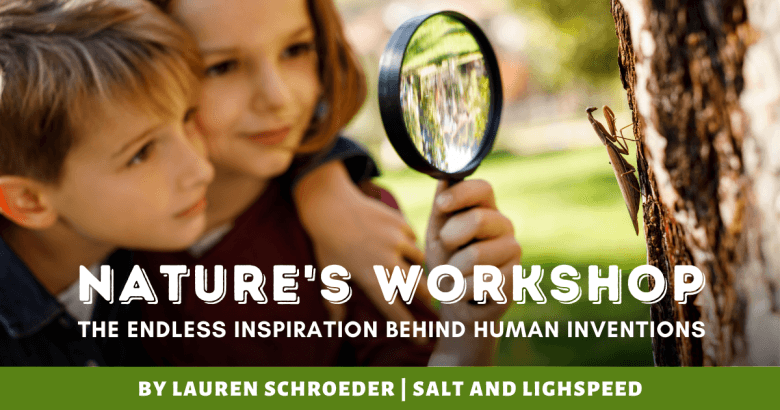By Lauren Schroeder of Salt & Lightspeed
Imagine your family having free access to the workshop of the greatest carpenter, the laboratory of the greatest scientist, or the think tank of the greatest strategist.
How much would you pay if any of these experiences were advertised in this magazine? What would your children learn? How would they be inspired?
I’m sure you know what I’m getting at, and you’re right: Nature is this workshop! It’s more than a front-row seat to moon phases or types of trees, as we so often simplify it to be. It’s an endless stage for inspiration.
Every invention that has ever been invented has been inspired by and crafted out of nature. It is the plant, sown by the master gardener, from which all human innovation springs.
Instead of worksheets, preplanned activities, or lessons, I want you to see five individuals who stepped into this grand workshop and came out with a spark of greatness.
The Cat's Eye
On a misty evening in rural England, Percy Shaw, a balding man from Yorkshire, is on his way home after enjoying an evening at a pub in town.
The road, known for being particularly dangerous, winds around windswept hills and occasionally around steep drops that lead to lush dales… as beautiful in the daytime as it is treacherous at night.
As he rounds one of the many bends, his headlights are reflected by two points of light. A cat was perched on a stone wall, right where Percy thought the road was supposed to be.
He cranks the wheel, narrowly missing crashing through the wall of solid stone and over a high drop into a dale. After making it home, Shaw wonders how he could harness the power of the “cat’s eyes” to help other weary travelers navigate dark roads.
Shaw sets to work in his makeshift workshop. After countless experiments and sleepless nights, he unveils his masterpiece—the "cat's eye" road reflector—a simple yet ingenious device that reflects the light of headlights in the same way that real cats’ eyes do.
He patented his design and created a company, forever changing the landscape of nighttime driving by guiding motorists safely home with the gentle glow of nature's own design.
Velcro
High up in the Swiss Alps, avid bird hunter George de Mestral and his Irish pointer weren’t hunting birds. They weren’t enjoying the view. They weren’t relaxing in the clear air of one of the most beautiful mountain ranges in the world.
They were sitting down, picking cockleburs out of their pants and fur. As he’s flicking another of the interminable seed pods away, he stops and examines it more closely. Hundreds of tiny hooks cover the surface, hooks that readily latch onto fabric and fur alike.
Intrigued by this natural adhesive mechanism, de Mestral shakes a few of the seeds into his pocket before continuing on his hike. Back at home, he studies the seed pod carefully, making notes about its design and dreaming up a man-made version.
He eventually finds a weaver who is willing to experiment with him, and together they invent velvet crochet… AKA Vel-cro.
Eastgate Center, Zimbabwe
Mick Pearce stands in the sweltering Australian summer. It’s over 100 degrees. A native of Zimbabwe, he is used to the heat, but still… he wipes the sweat from his brow and gazes at the towering termite mound in front of him.
This is what he came for. This behemoth termite mound, over 3 times the height of Mick, houses around 2 million termites, all enjoying temperatures some 20 degrees cooler than the baking outback that surrounds them. With their tunnels, water reservoirs, and ventilation shafts, termite mounds are wonders of engineering.
Pearce took his deep study of termite mounds back home to Zimbabwe, where he designed and built the Eastgate Centre in Harare—a mall and office building that regulates its temperature naturally.
By using a passive cooling system mimicking the termites’ structure, the mall can maintain a comfortable indoor environment year-round using only 10% of the energy required by other, similarly-sized buildings.
Bullet Train
Engineer Eiji Nakatsu watches a kingfisher dive into a pond. He rewinds, watching it flip out back-end first, slows down the video, then watches the bird dive in again. Even as the bird cuts through the surface tension of the water at almost 25 miles an hour, it barely makes a splash.
He had previously used the unique ridge-shaped feathers of owls to design a quieter high-speed train at his company in Japan. He was now turning to another bird to solve a different problem: how to allow his bullet trains to cut through the high-pressure tunnels without making their characteristic sonic boom.
Through countless experiments and iterations, he meticulously shaped a new type of train, the Shinkansen bullet train, whose nose mimics the kingfisher's beak. This new train has reduced air resistance which allows it to pass through tunnels in a much quieter, smoother way.
Adhesive Bandages
Dr. Robert Langer bends over his microscope, studying the contours and ridges of a gecko’s toe pad. Able to skitter up sheer walls and across ceilings without blinking, geckos have a remarkable ability to cling to wet, smooth surfaces, unlike any other creature.
Through study and computer modeling, Langer unlocked the secret to their unique adhesive properties.
He and his team sculpted surfaces with extremely tiny hills and valleys, textured ridges that mimic a gecko’s foot. They next turned to mussels, thin black clam-like organisms that cement themselves onto the sides of docks.
An adhesive inspired by the substance mussels use to cling to these wet, chaotic docks was then coated over the gecko bandage. The result? A bio-degradable bandage that can effortlessly cling to the smooth, wet wall of heart, bladder, or lung tissue.
So why tell you all of these stories?
Nature has a profound impact on human innovation. From Percy Shaw's road reflectors to Dr. Robert Langer's bandages, each invention draws inspiration from the natural world. They remind us of the power of observation, curiosity, and adaptability in problem-solving.
As we approach our children’s education, let’s think more deeply about their relationship with nature. Let’s not simplify it to an interesting setting where we can look at the moon and figure out what type of trees are in your backyard.
Those are wonderful activities, but it’s like visiting Leonardo Da Vinci’s studio and being content with talking about the type of nails in the floorboards.
Go out! Observe! Explore! Be curious! There doesn’t need to be a “lesson” involved. You are exploring the greatest fountainhead of innovation in the universe. As Einstein said, “Look deep into nature, and then you will understand everything better."
Read More!
- Log in to post comments






